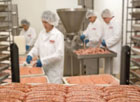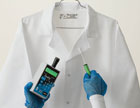
New coats, smocks and aprons possess pathogen-killing features that stop bacteria transfer by employees. Source: Aramark.

Food processors can expect more than just clean garments from uniform suppliers and launderers: the pathogen-control qualities of some food-safe fabrics are actually regenerated by laundering. Source: Aramark.
New fabric technology innovations take the uniform far beyond the simple smock color schemes many food processors have used to distinguish workers in one part of an operation from workers in another to prevent cross-contamination. Indeed, whether manufactured from pathogen-killing fabric or laundered to guarantee sterility, the uniform is the newest, if one of the most basic, and most effective means to inhibit pathogenic growth.
These new food-safe uniforms expand the definition of critical-control points in a food plant’s HACCP program to include a kind of mobile pathogenic hurdle. Today, uniform suppliers are an HACCP partner, supplying critical-control point verification and documentation.
“When looking at the role uniforms and garments play in a plant’s HACCP program, food processing customers should expect more than just clean garments,” writes Dr. Al Baroudi, president of the Food Safety Institute, in a white paper he prepared for uniform-maker Aramark.
“Uniform and work apparel companies must offer specialized HACCP-conscious uniform programs to companies whose success is dependent on food safety. Uniform companies should adopt a HACCP mentality as a part of their daily business, so their customers have one less control point to address. Uniform suppliers should include… SSOPs in their HACCP program to ensure every step of [the process guards] against cross-contamination,” he says.

New laundering protocols can give up to six-log kills on uniforms. Source: Aramark.
Chlorine cloth
Some uniform suppliers are on the front lines, beginning with the uniform fabric itself. The technology is so new, however, that food-safe uniforms are just now reaching the market. Just a few months ago, G&K Services, based in Minnetonka, MN, began marketing its BioSmart line of antimicrobial-charged garments and towels for the food industry.“We had a cutting-edge customer who was interested in taking food safety and quality assurance to the next level,” comments Chris Fisher, G&K’s senior marketing manager, “so we began to look around for a precedent, to see if there had been any customer trials, and there really weren’t any. That made us go back to the drawing board and start thinking about creating food-safe uniforms from scratch.”
Later, a discussion at an industry conference with one of G&K’s suppliers, a textile firm based in South Carolina called Milliken & Co., revealed that Milliken itself had been working on a food-safe fabric for about three years.
A special coating on the BioSmart fabric causes it to bind chlorine molecules to the surface of the cloth when a BioSmart garment is laundered with an EPA-registered chlorine bleach. The chlorinized fabric then continues to kill any pathogenic bacteria that happen to land on the uniform, reducing the possibility of cross-contamination as workers reach from one product to the next and move from one part of the plant to another.
Each time the garment is washed, the fabric’s bug-killing power is refreshed, up to 50-75 washes-“basically, the life of the garment,” notes Fisher.
The fabric “is always functioning at full strength,” adds Travis Greer, a fabrics technologist at Milliken. Lab tests conducted by APPTEC Labs in Atlanta, GA, showed the fabric to be effective at killing 99.9 percent of bacteria and viruses.
G&K says BioSmart fabric is non-irritating to human skin. In fact, it has passed ISO skin-irritation and skin-sensitivity tests. The line, which will be expanded, now includes a spun polyester butcher frock for meat plant workers, a food processing pant and frock that’s a 65/35 poly-cotton blend, a spun-poly apron and a 100-percent cotton terrycloth towel. So far, the only color available is white.
“We’re still working on dyes, such as light blue, that won’t bleach out in the chlorine washes,” says Fisher. The BioSmart items cost about 15 percent more than similar standard items. She also says BioSmart wet mops are under development, “and we’re looking at chefs’ clothing too.”
BioSmart is part of G&K’s proprietary ProSura Food Safety Solutions program launched two years ago. This comprehensive wash-to-delivery system guarantees food-safe uniforms and is a response to requests from customers for documentation they could use in HACCP programs.
Developed in partnership with microbiologists and laundry-ingredient suppliers, ProSura is the first closed-loop program that “ensures that at each step in the uniform laundering and delivery process, sanitizing and safety measures are implemented and documented, mitigating opportunities for contamination in food processing,” says Scott Wallace, G&K’s senior vice president of marketing. G&K can perform CFU tests in its laundry facilities as part of the ProSura process.
The BioSmart garments and towels, which were introduced to the food industry at the FMI show in May of this year, are now being used by a handful of food processors, but G&K declines to name them.
“This is a key tool for some of our customers, and they are naturally reluctant to show it off to their competitors,” comments Fisher.

BioSmart, from G&K Services, is a specially coated fabric that attracts and holds chlorine when garments made from the fabric are washed in a EPA-registered chlorine bleach. The fabric continues to kill pathogens that land on the uniform, reducing the possibility of cross-contamination as workers move to different areas of the plant. Source: G&K Services.
Stick-to-it-itiveness
According to Robin Pacey, marketing manager for protective apparel at Cintas Corp., in Cincinnati, OH, the uniform supplier looked at chlorine-binding technology but decided to go in a different direction. Cintas’ food-safe fabric for food processing plant uniforms, named Integrity 1800, uses a technology called Aegis Microbe Shield. The active ingredient is a silano-quat that is molecularly bonded to the fabric fibers rather than attached to them. Therefore, it will not wash out or require re-charging-a kind of pathogen-killing stick-to-itiveness.“The antimicrobial properties of the Integrity 1800 fabric have been validated for over 100 wash cycles,” comments Pacey, adding that “the Integrity 1800 fabric does not contain any ingredients that cause allergic reactions.”
Toxicity tests performed by the fabric manufacturer showed test subjects to be free from any observable skin irritation or skin sensitization. Integrity 1800 items cost about twice as much as Cintas’ standard uniforms for food processing operations.

The essential feature of new food-safe uniform fabrics is that they are not contaminated by food-to-fabric contact. Source: Cintas.
HACCP laundry
Both Cintas and G&K launder uniforms according to a log-reduction food-safe protocol. G&K uses the ProSure protocol. Cintas uses a microbe-reducing laundry process; it provides a six-log pathogen-reducing kill, or 99.999 percent.Meanwhile, UniFirst, in Wilmington, MA, has instituted a product protection process system that fits hand-in-glove with HACCP programs. In fact, the company developed the laundry procedure with critical-control points in mind. It begins with a dirty uniform pick-up by an HACCP-trained specialist and continues back at the UniFirst facility where, at the first critical-control point, HACCP garments are separated and stored in color-coded hampers. A documented wash cycle-160
The bug stops here
What distinguishes the UniFirst procedure, in the context of Baroudi’s comments, is that it is managed, and all the garments and critical-control points are inspected by HACCP-trained personnel.HACCP can be a paper-intensive protocol in some plants. “Because the responsibility of HACCP falls on the individual processing plant, it leaves some feeling like they are drowning in paper,” writes Dr. Baroudi. “If food plants rely on trusted vendors to provide sanitary uniforms, this could help alleviate a critical-control point within the plant.”
That’s where the HACCP-qualified uniform supplier comes in. Whether it supplies uniforms made from antimicrobial-charged fabrics or molecularly bonded antimicrobial fabrics, guarantees log reductions in laundry processes or provides HACCP-trained service representatives, a uniform supplier/launderer can be an HACCP partner. The new food-safe uniforms themselves create a front in the pathogen war: The bug stops here.
“By selecting the right uniform supplier, employee uniforms and garments can be a simple but effective way to increase plant hygiene and reduce cross-contamination,” Baroudi says.

Getting into hot water
Some uniform suppliers offer HACCP-approved or HACCP-inspired laundry services to complement the effectiveness of their food-safe uniforms. The following services also complement a food plant’s HACCP program with CCP verification and documentation.UniFirst, a member of the International HACCP Alliance, dotted its laundry procedure with critical-control points that are managed by HACCP-trained personnel, who also verify and document CCP effectiveness. The CCPs include dirty uniform pick-up, garment separation, wash cycle, steam-tunneling, visual inspection and polywrapping for distribution back to the food plant.
Cintas Corp.’s service, introduced in 1999, was the first validated microbe-reducing laundry process. It gives a six-log pathogen-reducing kill, or 99.999 percent. It’s also HACCP-verified, with document provision.
G&K’s ProSura Food Safety Solutions program, launched two years ago, is a comprehensive wash-to-delivery system. It is a closed-loop program that ensures each step in the uniform laundering and delivery process. Sanitizing and safety measures are implemented and documented. G&K can perform CFU tests in its laundry facilities as part of the ProSura process, and customers can receive the test results.
Uniform Suppliers
Aramark Uniform Services
115 N. First St.
Burbank, CA 91502
1-800-ARAMARK
www.aramark.com
Cintas Corp.
6800 Cintas Blvd.
Mason, OH 45040
1-800-CINTAS1
www.cintas.com
Clean Rental Services, Inc.
4326-4352 North American St.
Philadelphia, PA 19140
215-329-8000
www.cleanrental.com
G & K Services
5995 Opus Parkway
Minnetonka, MN 55343
1-800-GKCARES
www.gkservices.com
Omni Apparel
Carrollton, GA
1-800-951-COAT
www.omniapparel.com
UniFirst Corp.
68 Jonspin Rd.
Wilmington, MA 01887
www.unifirst.com
1-800-225-3364